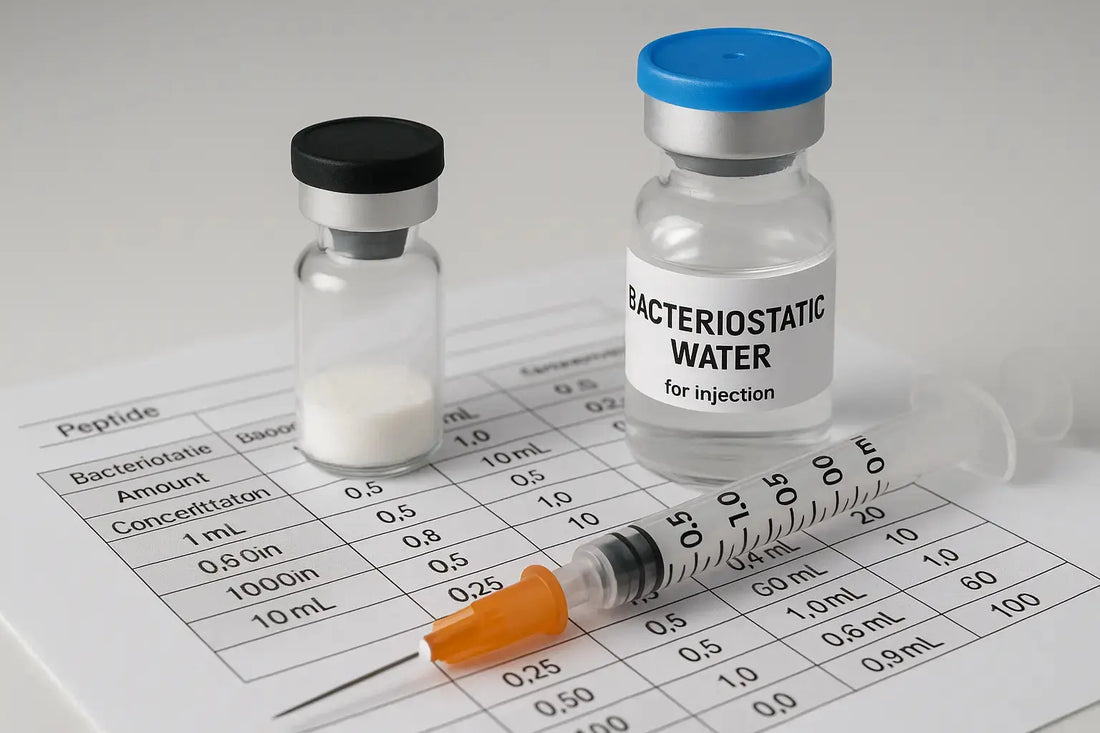
How to Reconstitute Peptides: Calculate Bacteriostatic Water Exactly
Share
Understanding how to reconstitute peptides properly is essential for anyone working with peptide powders. Accurate calculation of bacteriostatic water ensures peptides dissolve safely and at the right concentration for effective use. This guide offers a clear, step-by-step approach to determining exactly how much bacteriostatic water is needed to prepare peptides like 5mg semaglutide or 10 mg BPC 157 for research or application purposes. Equipped with precise calculations and best practices, you’ll confidently handle peptides from powder to solution with accuracy and safety.
Understanding How to Reconstitute Peptides
Why Proper Reconstitution Matters
Reconstitution means dissolving lyophilized peptide powder into a liquid solvent, typically bacteriostatic water, to create a usable peptide solution. Proper reconstitution preserves peptide stability, potency, and allows for accurate dosing. If too much or too little bacteriostatic water is used, concentration errors arise, which may undermine research outcomes or cause dosing inconsistencies.
Basics of Bacteriostatic Water Use
Bacteriostatic water contains 0.9% benzyl alcohol, which inhibits bacterial growth, making it ideal for multi-dose peptide vials. Unlike sterile water, it can be used repeatedly over several weeks when stored properly in a refrigerator. This added preservative ensures the peptide solution remains stable and safe from contamination during use.
Calculating the Exact Amount of Bacteriostatic Water
The Key Formula for Calculation
To calculate the bacteriostatic water volume for reconstitution, use this simple formula:
Volume of water (mL) = Amount of peptide (mg) / Desired concentration (mg/mL)
This calculation allows adjustment of concentration depending on the intended dose and injection volume. For example, reconstituting 5mg semaglutide for smaller, precise doses requires a different water volume than bulk preparation.
Practical Calculation Examples
- How to reconstitute 5mg semaglutide: If you want a concentration of 1mg/mL, add 5mL of bacteriostatic water to the 5mg vial.
-
How to reconstitute 10 mg BPC 157:
For a concentration of 2mg/mL, add 5mL of bacteriostatic water. This allows each milliliter to contain 2mg of peptide for easy dosing.
Adjusting volume changes concentration, so choose values aligning with dosing equipment and administration preferences.
Step-by-Step Guide to Reconstituting Peptides Safely
Gathering Supplies
- Lyophilized peptide vial (e.g., 5mg semaglutide, 10 mg BPC 157)
- Bacteriostatic water vial
- Insulin syringe (preferably 1 mL with unit markings)
- Alcohol swabs for sterilizing vial tops
- Clean workspace
Mixing Procedure
- Wipe rubber stoppers of peptide and bacteriostatic water vials with alcohol swabs.
- Draw calculated amount of bacteriostatic water into the syringe, avoiding air bubbles.
- Inject bacteriostatic water slowly at an angle on the vial wall to avoid foaming and degradation of peptides.
- Gently swirl the peptide vial until the powder dissolves completely—do not shake vigorously.
- Inspect solution for clarity and absence of particulates before storage.
Common Questions About Reconstituting Specific Peptides
How to Reconstitute 5mg Semaglutide
Research shows semaglutide requires careful reconstitution for consistent dosing. Adding 5mL of bacteriostatic water to 5mg semaglutide creates a 1mg/mL concentration, making it easier to measure smaller doses accurately. Use an insulin syringe to withdraw the required dose based on your protocol.
How to Reconstitute 10 mg BPC 157
Studies suggest BPC 157 is most effective when dissolved in moderate volume to balance solubility and concentration. Adding 5mL bacteriostatic water to a 10mg vial yields 2mg/mL concentration suitable for most applications. Adjust volumes slightly based on research or application protocol. Always ensure full dissolution before use.
Tips for Maintaining Peptide Stability After Reconstitution
Storage Best Practices
After reconstitution, store peptide solutions in a refrigerator at 2–8°C (36–46°F). Avoid freezing or exposing to light, which degrades peptide potency. Properly stored peptides in bacteriostatic water remain stable for up to 30 days.
Handling and Usage
- Always use sterile needles and syringes when drawing from vials to avoid contamination.
- Discard any peptide solution that appears cloudy or discolored.
- Never shake the peptide vial; mix by swirling to prevent damaging delicate peptides.
Where to Purchase Quality Peptides and Supplies
For reliable access to peptides and bacteriostatic water, consider suppliers like Everwell Peptides. They offer a trusted selection of research peptides with detailed product information and support. Having quality starting materials significantly improves reconstitution accuracy and peptide stability, enhancing your research outcomes.
By mastering how to reconstitute peptides with exact calculation of bacteriostatic water, you ensure precise concentrations, stable peptide solutions, and optimal research results. Whether working with 5mg semaglutide, 10 mg BPC 157, or any other peptide, following these steps maximizes safety and effectiveness. Explore peptide products and supplies to get started confidently today.

